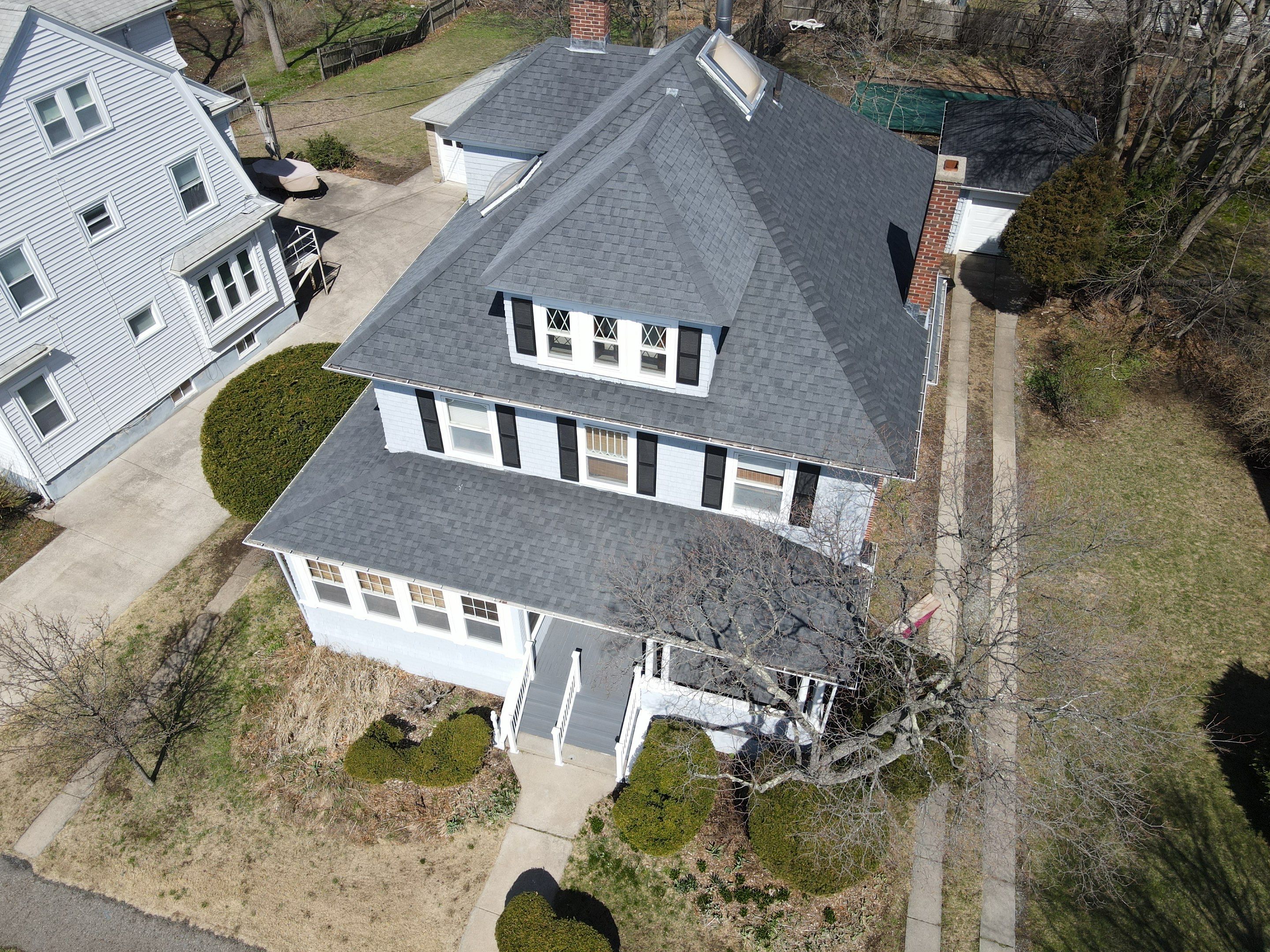
How hot does a roof get in the summer? Temperature guide
In the peak of summer, while you're trying to keep your home cool, your roof is silently enduring extreme temperatures. The surface temperature of your roof can soar far beyond the ambient air temperature, significantly impacting everything from your energy bills to the lifespan of your roofing materials. Understanding just how hot a roof can get, and what factors influence that heat, is crucial for making informed decisions about roofing materials and energy efficiency. Masterpiece Roofing provides a temperature guide to hot summer roofs.
Dark asphalt shingles: 140–190°F on sunny days
Dark-colored asphalt shingles are notorious for absorbing a significant amount of solar radiation, leading to very high surface temperatures.
Average Range: On a sunny summer day when the ambient air temperature is 90°F (32°C), the surface of a dark-colored asphalt shingle roof can reach temperatures ranging from 140°F to 190°F (60°C to 88°C).
Heat Absorption: Dark colors absorb a higher percentage of the sun's infrared (heat) radiation compared to lighter colors. This absorption directly translates to a much higher surface temperature.
Impact: This extreme heat directly contributes to faster degradation of the shingle's asphalt and rapid loss of its protective granules, significantly shortening its lifespan. It also transfers substantial heat into the attic below.
Metal roof: 138–145°F unpainted; cooler with reflective paint
Metal roofs have a unique thermal profile, often performing better than asphalt shingles, especially when coated.
Unpainted Metal: An unpainted metal roof (e.g., galvanized steel, galvalume, or bare aluminum) can reach surface temperatures around 138°F to 145°F (59°C to 63°C) on a hot, sunny day. While still hot, this is often slightly lower or comparable to the lower end of dark asphalt shingles, as metal has higher thermal emissivity (it releases absorbed heat more readily) and can be less absorptive depending on its finish.
Reflectivity: The key advantage of metal roofs lies in their potential for high reflectivity. Factory-applied coatings or post-installation paints can dramatically reduce their surface temperature.
Color Matters: Just like with shingles, the color of the metal roof plays a huge role. A dark, unpainted metal roof will absorb more heat than a light-colored one.
Painted metal (cool paint): 105–115°F, ~42% cooler
This is where metal roofs truly shine in terms of thermal performance.
Significant Reduction: When a metal roof is painted with a "cool roof" coating or a high-quality, light-colored reflective paint, its surface temperature can drop dramatically to 105°F to 115°F (41°C to 46°C).
Percentage Cooler: This represents a significant reduction, potentially making the roof surface ~42% cooler than a dark asphalt shingle roof on the same day. This difference is due to the paint's ability to reflect a high percentage of the sun's energy rather than absorbing it.
Benefits: This reduced surface temperature translates directly to less heat transfer into the attic, lower cooling loads for the building, and increased energy savings.
White coat: 102–120°F stays cooler
White is the champion of reflectivity for most roofing materials.
Optimal Reflectivity: Whether applied as a coating on a flat membrane roof (like TPO or modified bitumen) or as a specialized paint on metal or even asphalt shingles, a white surface is the most effective at reflecting solar radiation.
Temperature Range: A white-coated roof can maintain surface temperatures between 102°F and 120°F (39°C to 49°C) on a hot summer day. This makes it one of the coolest conventional roofing options.
Benefits: The superior reflectivity of white surfaces significantly reduces heat gain, lowers energy consumption for cooling, and extends the life of the roofing material by protecting it from extreme thermal stress.
Green roofs: ~90°F due to evapotranspiration
Green roofs (also known as living roofs) offer exceptional thermal performance through a natural process.
Nature's Cooling System: A green roof, with its layer of vegetation, soil, and drainage, can maintain a surface temperature remarkably close to the ambient air temperature, typically around 90°F (32°C) on a 90°F day.
Evapotranspiration: The primary cooling mechanism is evapotranspiration. Plants absorb solar energy and use it to convert water into vapor, which is then released into the atmosphere. This process acts like a natural air conditioner, actively cooling the roof surface and the surrounding air.
Benefits: Beyond cooling, green roofs offer benefits like stormwater management, improved air quality, habitat creation, and increased roof lifespan by protecting the membrane from UV and thermal stress.
Impacts: Shingle lifespan, attic heat, energy efficiency
The extreme temperatures a roof endures have significant consequences for your home.
Reduced Shingle Lifespan: High surface temperatures on asphalt shingles accelerate the breakdown of the asphalt binder and cause the protective granules to fall off. This leads to premature curling, cracking, and brittleness, drastically shortening the roof's useful life and necessitating earlier replacement.
Increased Attic Heat: A hot roof radiates significant heat downwards into the attic space. An unventilated or poorly ventilated attic can then reach scorching temperatures, often 20-40 degrees higher than the outside air.
Decreased Energy Efficiency: This superheated attic acts like a giant radiator, transferring heat into the living spaces below. This forces your air conditioning system to work harder, run longer, and consume more energy to maintain a comfortable indoor temperature, leading to higher electricity bills.
Compromised Insulation: While insulation reduces heat transfer, extreme attic temperatures can still compromise its effectiveness over time, especially if moisture accumulates.
Ice Dam Contribution (Winter): In colder climates, heat escaping from the living space into a hot attic can melt snow on the roof, leading to refreezing at the eaves and the formation of destructive ice dams.
Cool roof benefits: Reflective materials, coatings, greening
Implementing cool roof strategies is an effective way to mitigate these impacts.
Reflective Materials: Choosing roofing materials that are inherently reflective.
Light-Colored Shingles: Opting for lighter-colored asphalt shingles certified by the Cool Roof Rating Council (CRRC) can still offer better reflectivity than dark options.
Light-Colored Metal Roofs: Pre-painted light-colored metal roofs are highly reflective and durable.
Single-Ply Membranes (TPO, PVC): These commercial roofing materials often come in white or light colors with naturally high solar reflectivity.
Cool Coatings: Applying specialized reflective coatings to existing roofs.
Elastomeric Coatings: These are highly elastic, reflective liquid coatings that can be applied to various roof types (metal, modified bitumen, concrete, even some shingle roofs). They create a seamless, highly reflective surface that significantly reduces heat absorption.
"Cool Paint": Specific paints formulated with highly reflective pigments for metal roofs, as discussed above.
Greening (Green Roofs): As detailed, installing a green roof provides an exceptional level of cooling through evapotranspiration, while also offering numerous environmental benefits.
Benefits of Cool Roofs:
Reduced Energy Consumption: Lower cooling costs for the building.
Extended Roof Lifespan: Protecting the roofing materials from extreme thermal stress and UV degradation extends their useful life.
Improved Indoor Comfort: A cooler attic means less heat radiating into the living space, improving comfort without overworking the HVAC.
Reduced Urban Heat Island Effect: Widespread adoption of cool roofs in urban areas can help lower ambient air temperatures, benefiting entire communities.
Environmental Benefits: Lower energy consumption means reduced greenhouse gas emissions.
Understanding roof temperatures empowers homeowners to make smart choices that contribute to a more comfortable home, lower energy bills, and a longer-lasting roof.
Is your roof turning your home into an oven in the summer? Masterpiece Roofing specializes in energy-efficient roofing solutions, including cool roof materials, reflective coatings, and expert installation of systems designed to keep your home cooler and your energy bills lower. Protect your investment and enhance your comfort. Contact us today for a consultation and let us build you a truly masterful, cool roof!
Office: 1248 Highland St, Holliston, 01746 MA
(508) 882-6080
Email: office@buttonmasterpieceroof.com
Site: www.masterpieceroof.com
Assistance Hours
Mon – Fri 8:00am – 4:00pm

